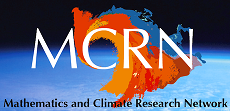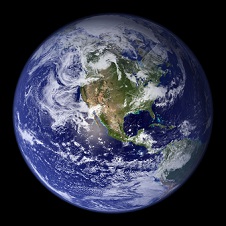|
MCRN-MN Mathematics of Climate Seminar |
 |
Fall 2019 Schedule
September 10, 2019
The Scientific Case for Anthropogenic Warming I, Richard McGehee, School of Mathematics
Scientific evidence overwhelmingly indicates that the Earth's surface temperature is warming and that the primary cause of the warming is the increase in the concentration of carbon dioxide in the atmosphere. The evidence also indicates that human activity is the major source of the increase.
September 17, 2019
The Scientific Case for Anthropogenic Warming II, Richard McGehee, School of Mathematics
September 24, 2019
An Introduction to Planetary Energy Balance, Richard McGehee, School of Mathematics
Large-scale features of climate can be explained with very simple models using only basic physics.
October 1, 2019
An Introduction to Budyko's Energy Balance Model, Richard McGehee, School of Mathematics
Budyko's equation models the global mean surface temperature as a function of latitude, taking into account the solar input, the surface albedo, the outgoing radiation, and the redistribution of heat across latitudes. Since the surface albedo is a function of latitude, the equation can be used to model glaciations.
October 8, 2019
Permafrost Response to Climate Change via Budyko’s Model, Richard McGehee, School of Mathematics
Budkyo's model can be used to predict the loss of Arctic permafrost due to increased global temperatures.
October 15, 2019
Climate and Non-Smooth Dynamics, Cameron Thieme, School of Mathematics
October 29, 2019
Convergence and Equilibrium for Stochastic Models of Ecological Disturbances, James Broda, Bowdoin College
Imagine a forest full of trees. As time passes, the amount of carbon stored in the trees increases due to photosynthesis. Occasionally, a forest fire or other disturbance occurs, and reduces the amount of carbon stored in the ecosystem. Both the time intervals between disturbances and the severity of the disturbances exhibit stochasticity. An interesting question is whether there exists a unique equilibrium distribution for the amount of carbon stored in such an ecosystem. In many cases, the answer is yes. Moreover, we can use probabilistic techniques to compute explicit bounds on the rate of convergence to equilibrium.
November 5, 2019
Permafrost-affected soils in Alaska: Distribution, comparative morphology, and change, Nic Jelinski, Department of Soil, Water and Climate, University of Minnesota
Permafrost-affected soils (classified as Gelisols in U.S. Soil Taxonomy) are widely distributed across the zones of continuous, discontinuous, and sporadic or isolated permafrost in Alaska. Drivers of near-surface permafrost are varied, and differ between climate- and ecosystem-driven permafrost. The morphology of permafrost-affected soils also changes predictably in response to soil forming factors and between zones of continuous and discontinuous permafrost. In particular, cryoturbation (soil mixing through freeze-thaw processes) patterns and processes vary at regional scales and play an important role in soil morphological development, soil carbon storage, and ecosystem function. The comparative morphology of cryoturbated soils can be utilized to better understand the mechanisms which drive cryoturbation processes in different environments. Finally, using models of future near-surface permafrost distribution under an A1B emissions scenario (GIPL 1.3 and Pastick et al (2015), potential scenarios of future taxonomic change in the Gelisols of Alaska will be discussed.
